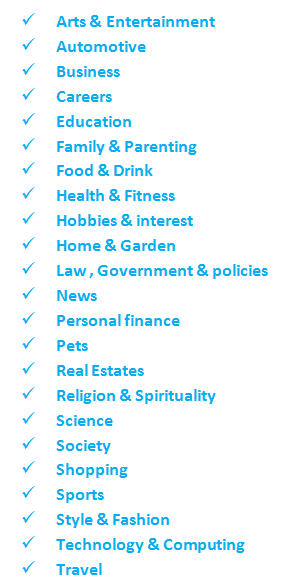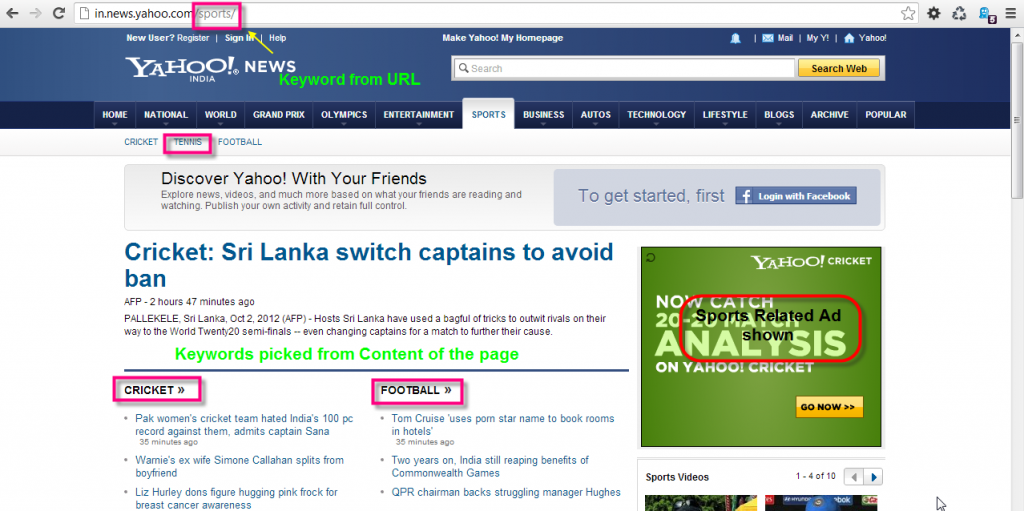
Contextual meaning says ” relating to or determined by or in context”, so when it’s about contextual advertising it means the Ads shown as per the content of the webpage is contextual advertising and the targeting is called contextual targeting. It is also a kind of targeted advertising in which Ads are always shown as per the contents present on a webpage, e.g. if a user will be on a sports website he will be shown Ads related to sports, if in any entertainments site he will be shown Ads of movies, music, etc. Contextual advertising is also called “In-Text” advertising or “In-Context” technology, In-Text advertising has a small difference i.e. it works when a specific word or keywords within the text of a web-page are matched with advertising and/or related information units.
To define in one go “Contextual targeting is a technique in which the web page is scanned to show the relevant Ad as per the content on the page”.
Technically if you define “Contextual targeting is a technology which uses artificial intelligence to define and understand content rich websites and match them with targeted keywords so as to show up related Ad as per the content of the page”
The advertisements themselves are selected and served by automated systems based on the content displayed to the user.Contextual Advertising is in huge demand today as it brings good profit in return plus it’s the latest online advertising technological advance and allows a company to place advertisements in major websites and portals that are carrying relevant content for their product or service which thereby bringing good response.
“Just in a case , think as a user when you are searching for some property to buy and searching number of real estates site and if some good property related Ads are shown to that user , there will be percentage of chance that user will show his interest on it as he is searching the related information only .”
CATEGORIES :
We have a number of categories defined but as per IAB standards, the list can be of 23 top-level categories and around 200 categories in total (including subcategories).

Within these, we have a number of sub-categories which can be targeted too.
How does CONTEXTUAL TARGETING works?
Contextual targeting generally works through a piece of code that you put on your web pages. The function of the code is to look through what is on the page and pull relevant ads from the company sponsoring the contextual targeting, which it then places on the site.
Contextual targeting is totally a dynamic approach. When a user requests a page, the page will have a JavaScript code embedded on it which will make a request to an Ad server with some metadata information about the context of the page. This information could be a number of options like the URL of the page, the page content, or to be specific the section of the site where the user is… All these information are passed not as a text but as keywords (Keywords are chosen plays the game in the working of contextual targeting ) which will be more than enough for an Ad server to understand the context of the page but that highly depends on the Ad server potential. Every Ad server has it own targeting rules to be followed, for e.g. the keyword passed by the javascript say “sports” will co-relate with rule or condition set for sports category in the ad server and will then serve the content specific ad from the ad server.
Say an Ad Network is having a contextual targeting of sports channel for a particular product say a badminton racket and a publisher say ESPN sports has embedded a code ( helps in contextual targeting ) in his page to show Ads related to its content. So whenever a user who shows interest on badminton page of the ESPN site, automatically the Ads related to the same context will be pulled up from the Ad Server to be shown on the page.
Screenshot Explanation :
The advantage of CONTEXTUAL TARGETING :
- Greater engagement
- Higher conversion
- Content or Ads can be automatically matched to your content
- More benefit for publishers as higher chances of clicking on the Ad
- Relevant Ads as per the content don’t annoy the user
- Saves unnecessary impressions

Interested in buying inventory from your platform. Please put us in touch with the right contact.